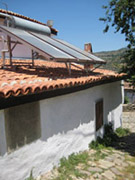Solar Energy
Generating Heat Passively with Solar Energy
Just as sunlight is used to heat the circulating oil at a solar power plant, we passively use the heat of the sun's rays in our everyday life.
| When sunlight hits something, it generates heat, or thermal energy. On a sunny day, the sunlight hits your car and heats up the inside. Sun shines on your couch and the cat snuggles there in the warmth. Sunlight hits your laundry on the line and the heat dries the clothes. |  |
 |
 |
Passive solar heating systems rely solely on this principle. They do not concentrate the energy and there is no mechanical system. Therefore, no electricity is used. In homes and buildings, passive solar heating systems can be used to heat water or interior spaces. The problem with these systems is they rely on good sunshine and they function best in moderate climates.
 |
Heating Water: Homes can use passive solar heating to provide hot water for showers and washing dishes. Thin rectangular tanks with a glass front are positioned on the roof. The water circulating through the tank is heated by the sun's energy. The system relies on gravity to deliver hot water on demand. |  |
Heating Spaces: Greenhouses use passive solar heating but homes and other buildings can too. Glass windows are transparent to visible light, which warms in interior space. However, glass is opaque to infrared wavelengths given off by the interior, so the heat is trapped (thus the "greenhouse effect"). In warmer weather, an overhang can prevent sunlight from entering through the windows. |

